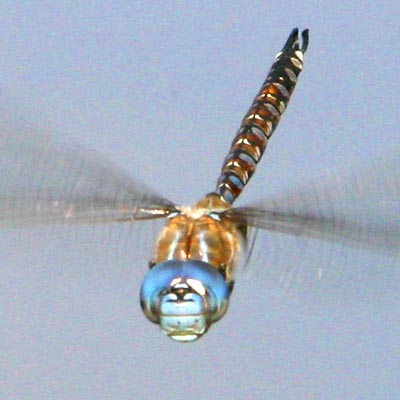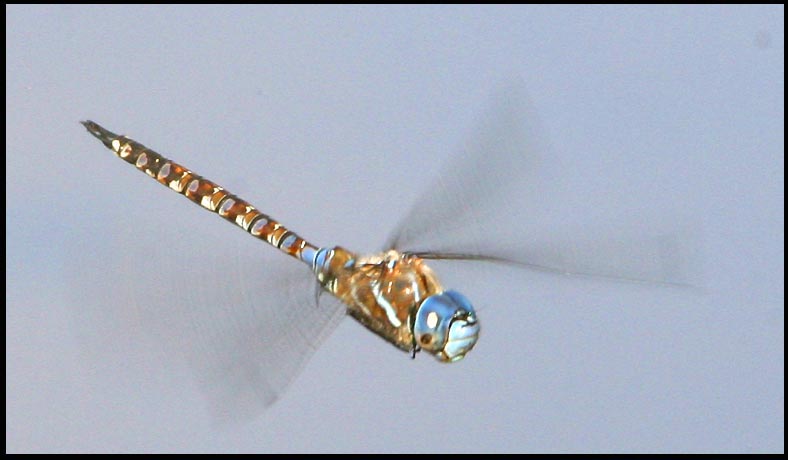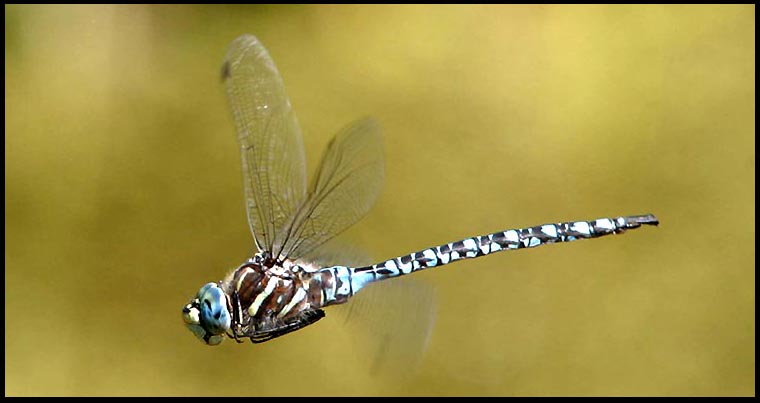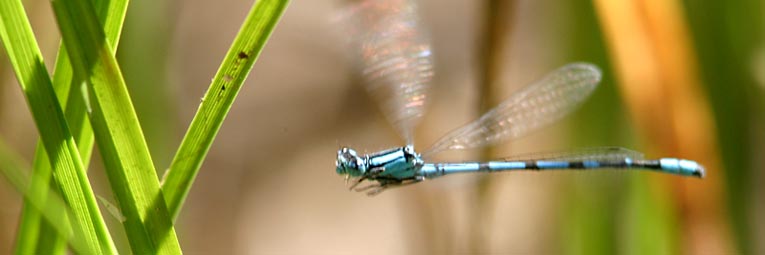| I would likely have never become interested in dragonflies but for
digital photography. Yes, odes are colorful and intriguing in their own
right; they can fly and sometimes migrate; they can be an identification
challenge; and they are 'manageable' to learn (only 110 species in California)
in a way that, say, beetles are not. But they are also small and often
moving, and seeing details can require either (a) catching them or (b)
photographing them. The ability to take photos and see details instantly
through digital photography was the single element that, for me, changed
them from slightly intriguing to a mild obsession. |
|
 While
digital photography is a wonderful personal tool, my snaps don't add much
for the broader audience. With the exceptional dragonfly photography of
Ray
Bruun, Greg Lasley,
and Eric Preston on the web
(to name just three of a dozen or more great odonata web pages), nearly
all western North American odonates are already very well represented in
stunning color photos. So, to the extent possible, I've been working on
shooting dragonflies in flight. There are comparatively few flight shots
of even common California species currently on the 'net. While
digital photography is a wonderful personal tool, my snaps don't add much
for the broader audience. With the exceptional dragonfly photography of
Ray
Bruun, Greg Lasley,
and Eric Preston on the web
(to name just three of a dozen or more great odonata web pages), nearly
all western North American odonates are already very well represented in
stunning color photos. So, to the extent possible, I've been working on
shooting dragonflies in flight. There are comparatively few flight shots
of even common California species currently on the 'net.
Here is a head-on flight shot of a Blue-eyed Darner (right).
What I particularly like about this shot is that the depth of field was
great enough to see both the face and the terminal appendages in some detail.
I've been trying a technique suggested by Paul Johnson [the Lavender
Hill Man]. All my early flight shots used the automatic features of
the Canon D10 to pick speed and exposure. This often resulted in a fast
shutter speed and a low f-stop (e.g., 1/1000 at f5.6). This choice may
stop the wings but results in a very shallow depth of field. More recently,
I've been doing a lot of shooting at manual exposures (e.g., 1/250 at f11
for the same subject). This gives a much better depth of field but the
wings become a blur.
Here is a profile shot of the same Blue-eyed Darner (below) and
then, below it, a shot of Paddle-tailed Darner from Alpine County
using the 'automatic' exposure feature. |

|

| Note that the fast shutter sped on the Paddle-tailed Darner does 'stop'
the wings in mid-stroke, and allows study of, say, the pterostigma. But
everything is a trade-off. I generally prefer the option that permits more
depth of field, and it also gives the illusion of motion (the moving wings),
The depth of field shows a broader range of details, but those shown may
not be a crisp as the faster shutter speed.
All the flight shots require manual focus. The automatic focus feature
is too slow and inefficient on these small and fast subjects. Manual focus
on a flying dragonfly is very tough — and one shoots a lot of shots to
get anything decent at all. Fortunately, digital photography permits one
to throw away all the bad photos at no cost.
The other thing I try to get in photos of flying dragons is a uniform
background that complements the subject. Both the Blue-eyed and Paddle-tailed
Darners were shot while they were in flight over water — and that does
provide a fine background composition. |
photos of Blue-eyed Darner 25 Sep 2006 Salinas
River nr Salinas MTY
photo of Paddle-tailed Darner 19 Aug 2006 Heenan Lake
ALP
|
 While
various mosaic darners do sometimes hover over water, permitting attempts
at flight photography, I've had a bit more trouble with Common Green
Darner (right & below). There was a male at Laguna Grande park
in Seaside, Monterey County (right), that often briefly stopped at the
same spot — and I've pointed the camera at him a bunch of times with only
okay success so far. When the legs are tucked in, they look like a black
belly patch. While
various mosaic darners do sometimes hover over water, permitting attempts
at flight photography, I've had a bit more trouble with Common Green
Darner (right & below). There was a male at Laguna Grande park
in Seaside, Monterey County (right), that often briefly stopped at the
same spot — and I've pointed the camera at him a bunch of times with only
okay success so far. When the legs are tucked in, they look like a black
belly patch.
photo (right) 19 Sep 2006 Laguna Grande park, Seaside
MTY
photo (below) 20 Sep 2006 Laguna Grande park |
 |
| Darners — and spiketails, cruisers, emeralds, gliders, and saddlebags
— seem always to be in flight, so flight photography is often the only
choice during a day's outing. Not so with the damselflies that sit around
for portraits, if you have a macro lens. So far my flight shots of them
— like the Boreal Bluet below — are marginal. But perhaps it partially
illustrates one of the most amazing features of Odonata: each wing is independently
operated — the only four-winged critter on earth of have that ability. |

|
|
photo (above) 20 Aug 2006 Donner Summit
NEV
|

|
|
photo 19 Sep 2006 Laguna Grande park, Seaside
MTY
| Finally, I was surprised to find that my effort at flight photography
of Wandering Glider (above) ended up looking like one of Kathy Biggs's
scans! But it actually is a glider in foraging flight, with its legs tucked
up to reduce drag. Almost surrealistic . . . |
|
| PHOTOS: All photos are © 2006 Don Roberson; all rights
reserved.
TOP
TO PORTAL
PAGE OF DON'S ODONates
TO BIRD FAMILIES
OF THE WORLD
TO MONTEREY COUNTY
PAGE
TO HOME PAGE
|



